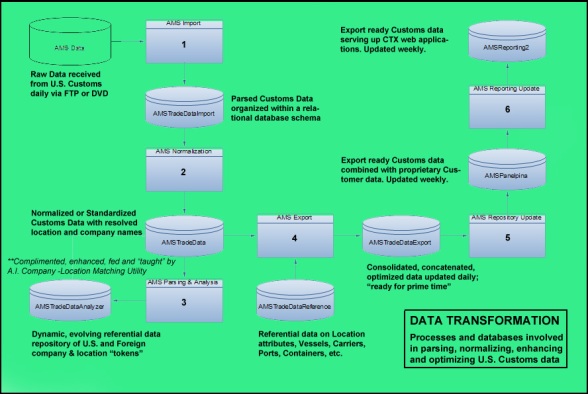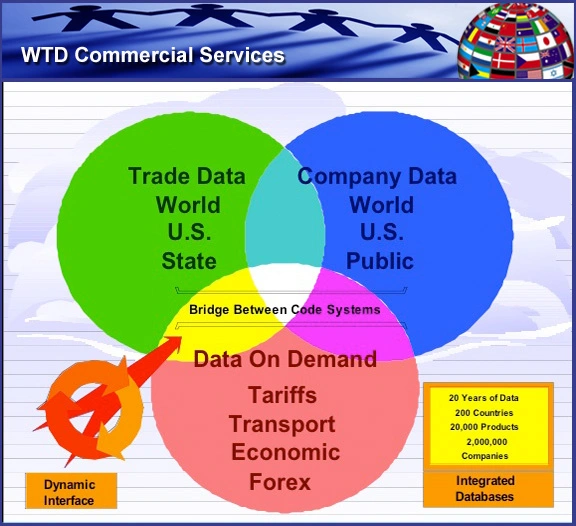We concluded our first year of consecutive daily publishing with the announcement of a new format and focus: We’re going to be conducting extensive coverage of the $2 trillion of annual U.S. Import Trade.
For the past 120 days, prior to our September 1st launch of WTD 2.0, while we are busily compiling the extensive background data required for this project (and looking for a commercial sponsor and University partner), we republished selected articles from the previous year.
Please check out the complete details in several of our recent articles:
- WorldTradeDaily.com Concludes First Year of Publication with Launch of WTD 2.0
- WTD 2.0 Coming July 1, 2012 Will Focus on $2 Trillion of U.S. Import Trade Flows
- WorldTradeDaily.com is Seeking Commercial Sponsor and University Partner for WTD 2.0
However, over the last several months, in discussion with several of our advisors, we have further refined our intention. Specifically, we want to address U.S. Waterborne Import Trade. There are several reasons behind this decision. First of all, two-thirds of all U.S. import trade is waterborne. Secondly, transactional data is only available for waterborne imports. Taken together with statistical and company data the three-fold combination is powerful. Therefore, if we focus on U.S. Waterborne Import Trade, we will be able to provide granular shipment detail, lists of both foreign suppliers and U.S. importers as well as trend analysis and strategic statistical overview… in each and every article… comprehensively representing every significant imported (via Water/ by Vessel) product.
Our plan is that during the 250 or so weekdays (Monday – Friday) of the forthcoming year (commending August 1st), we will report on specific products and commodities within the major (4 digit) product groups (those exceeding $1 billion dollars). There are 170 product groups (of the 1250 total) that fit within this threshold thus together our selected product groups represent over $1 trillion of annual U.S. waterborne import trade.
In each story, we will expand upon the highest ranked (by import dollar volume) 6 digit sub-category within its respective 4 digit (billion dollar) parent. In cases in which a particular 4 digit product heading has more than one billion dollar 6 digit “child” subcategory, we will develop an article for that product as well.
The purpose behind focusing articles on the top ranked 6 digit codes is that it lends to the greatest amount of specificity and business application. By covering the largest couple of hundred products individually, we will develop – over the course of one year – the most comprehensive (and hopefully useful) detailed analysis of U.S. Waterborne Import Trade available.
Those 4 digit Product groups that fall below the billion dollar threshold will be covered in summary fashion within their respective HS section or HS chapter heading for which we plan to dedicate a couple of dozen additional stories.
The graph below depicts a sample of the products for which we will be developing individual articles. We have intentionally groomed the list as to eliminate all but the top 6,000 plus HS 6 digit products.
Under HS Chapter 20, “Prepared Vegetables & Fruits” (Approx. $6.5 billion total import trade of which $4.6 billion came via water):
- 4 digit product group 2008 “Prepared Fruits & Nuts” is ranked in excess of $1 billion waterborne import trade but doesn’t have any billion dollar 6 digit “babies”; therefore we will choose one or both of the largest sub-groupings (Pineapples and/or Citrus Fruit) to develop.
- Apple Juice ($672,868,720) is the largest sub-category under 2009 “Fruit Juice”, therefore it will be the subject of an article.
Under Chapter 22 “Beverages & Spirits” we will develop a handful of articles.
- For 2202; 220210 – “Flavored Waters” ($1,043,205,967 waterborne imports)
- Under 2203; 220300 Beer ($1,703,419,096 waterborne imports)
- Under 2208, there are two sub-categories of $1 billion each: Whiskies and Vodka. Therefore we will dedicate an article to each.
Chapter 24 Tobacco, although it generated $1,273,160,265 in Waterborne imports, doesn’t contain any 4 digit product categories in excess of $1 billion. Therefore it will be covered in our HS section and HS chapter summaries.
Notwithstanding our focus on U.S. Waterborne Import Trade, we will continue to reserve weekend articles to pertinent international trade and economic news, op-ed pieces and articles contributed by our WTD community of readers. That’s the plan for now.


 31/08/2012
31/08/2012 
























































 World Use Trend of Nitrogenous Fertilizers
World Use Trend of Nitrogenous Fertilizers










 Tampa Bay’s history of manufacturing for the defense industry has created a highly skilled workforce, who are now employed in other industries like medical manufacturing. The bay itself is very shallow, less than 30 feet in many spots, which requires almost constant dredging to allow shipping.
Tampa Bay’s history of manufacturing for the defense industry has created a highly skilled workforce, who are now employed in other industries like medical manufacturing. The bay itself is very shallow, less than 30 feet in many spots, which requires almost constant dredging to allow shipping.













































 Baltimore’s Exports
Baltimore’s Exports


































































































































































































































































































































































